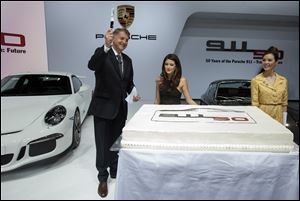
AUTOMOTIVE INDUSTRY
Don’t look for these 7 features in that new car
Technology is making standard items obsolete
2/16/2014The next time you test drive a new car, you might be in for a shock.
If you expect a place to stash your stogie or a slot to slip in your copy of Nirvana’s “Smells Like Teen Spirit,” you’re in for a surprise. Most likely, that new car won’t accommodate you.
Call it the march of time or the onslaught of technology, but there are seven features your next car most likely won’t have.

Automatic transmissions like the one in this 2014 Porsche 911 GT3 know when to shift better than you do and return better fuel economy than manual transmission models.
● Manual transmission: As the microchip controls more and more of your car’s powertrain, it stands to reason that automatic transmissions know when to shift better than you do and return better fuel economy than manual transmission models. And they can shift more quickly as well. If you need proof, consider that sports cars, such as the 2014 Porsche 911 GT3 and Jaguar F-type, don’t offer them. In fact, fewer than 4 percent of cars sold in the United States last year had manual transmissions.
● Mechanical parking brake: Many newer cars now have replaced mechanical parking brakes with electronic parking brakes, actuated at the touch of a button. Like many new electronic systems, its main advantage is its light weight, which helps increase fuel economy. But the brake’s computer also can be configured to release the brake automatically when the vehicle accelerates or activate the brake when the driver’s door opens.
● Keys: Unlocking and starting a car with a key was simple and secure. Now, “smart” key fobs allow you to unlock the car by tugging a door handle and start it by hitting the starter button, all without fumbling in your purse or pocket to find it. No key required. It is convenient, although recent studies show that they are easy to hack. So don’t be surprised if they’re eventually replaced by smart-phone applications.
● Spare tire: Don’t look now, but your next car may not have a spare tire. In an era when automakers are watching every ounce in an effort to maximize fuel economy, ditching the spare tire and jack saves 26 pounds. In its place you’ll find a tire-inflation kit. Helpful? Not exactly. That’s why many pricier cars have run-flat tires, which don’t require a spare but still can leave you stranded.
● Gas cap: Open the fuel-filler door on a new vehicle and you may be surprised to find that there’s something missing: the gas cap. Many Ford vehicles, as well as others, no longer have one. Instead, the fuel-filler door has a gasket that effectively seals the fuel filler neck. This means that you no longer risk leaving the gas cap sitting on the gas pump or on top of your car, and you are always assured of closing it effectively.
● Ashtrays: If you think that roadsides seem increasingly littered with cigarette butts, there’s a reason. It’s difficult to find a car with a front-seat ashtray and lighter. That spot now is given to space for a mobile phone, USB port, and an auxiliary power point. If you need an ashtray and lighter in your new ride, it can usually be found as an option package — if it’s offered at all.
● CD player: When was the last time you bought a compact disc? Odds are it wasn’t this year. According to the Recording Industry Association of America, 60.1 percent of music is purchased digitally. This is why the number of vehicles that include a disc drive dropped 75 percent in 2013. Instead, they offer software to connect a digital device to the car’s audio system.
● Bench seats: The once-ubiquitous bench seat is no longer offered in passenger cars. Blame it on fashion as much as function, as they add an illusion of sportiness. Ideally, bucket seats have more side support than bench seats, although in reality many bucket seats are little better in that regard. Still, a bench seat offers more than room for another passenger; it also allows space for purses and bags.